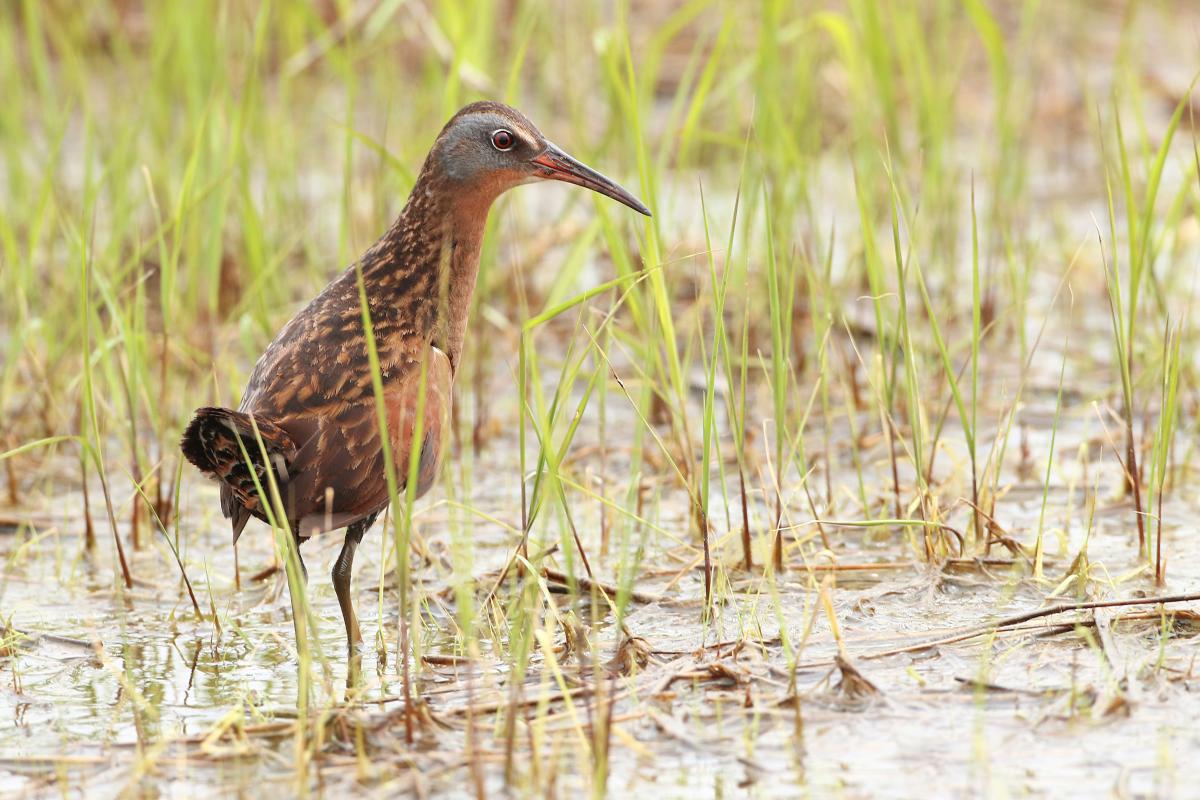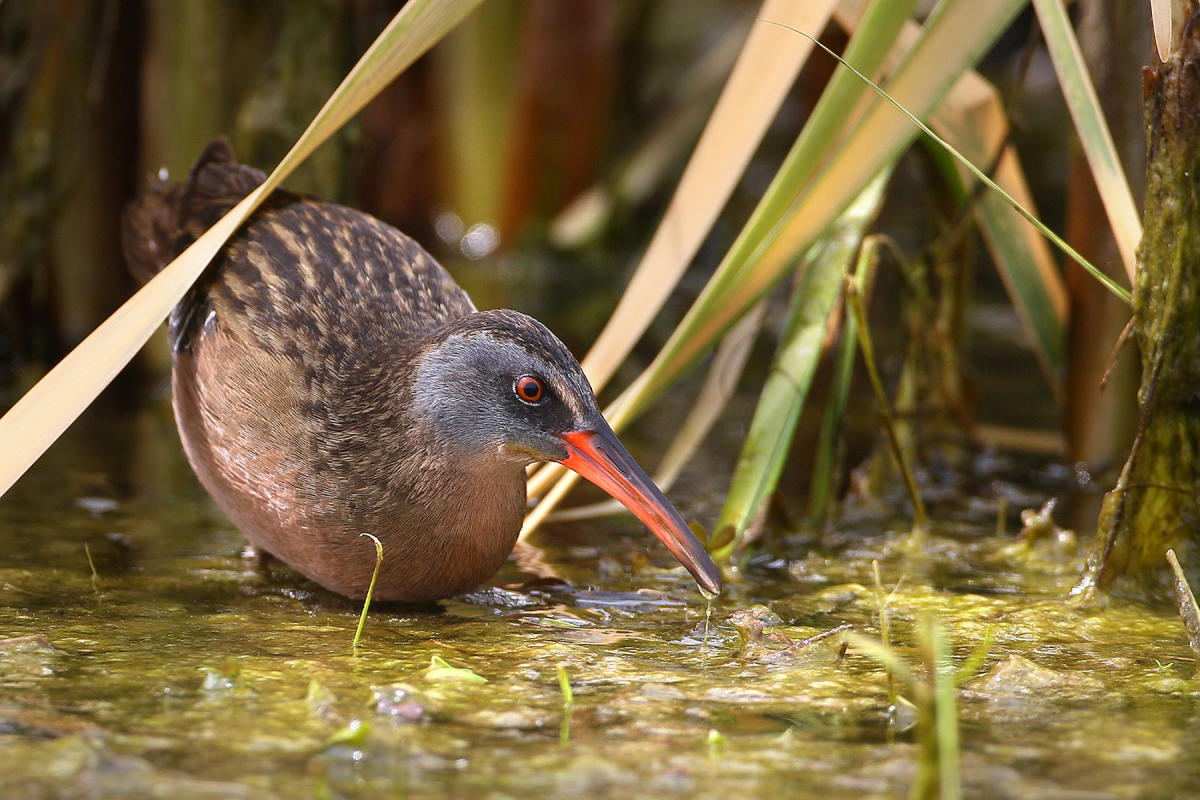Spring has sprung and that means our Kankakee Sands wetlands are teeming with activity. The Kankakee Sands Bird Viewing Area on the west side of US 41 is a particular fan favorite right now due to the wide-open wetland filled with glistening water and critters galore. One needn’t walk through a wetland to enjoy it; a leisurely rest at the water’s edge will allow you to hear the many sounds of the spring wetlands – splashing, chirping, croaking and maybe even the squeaking of the Virginia Rail.

The Virginia Rail (Rallus limicola) is a state-endangered bird that thrives in the wetlands of Kankakee Sands. This nearly 10-inch tall, thin-as-a-rail waterbird looks chunky when viewed from the side, is actually quite slim when viewed from the front. The bird’s slenderness allows it to easily slip between the stems and stalks of such wetland plants as reeds, rushes, grasses, and sedges as it probes the shallow water and mud in search of a meal of insects, snails, spiders, and even small fish and frogs! The best time to try to catch a glimpse of the gorgeous Virginia Rails is at dawn or dusk, when it is moving in and out of the vegetation in search of food.

Spring is an exceptionally good time of year to try and see Virginia Rails. Had you come last month, they likely would still have been in their wintering habitat in Mexico and the southern coast of the United States. But now they have returned to their spring/summer range, which includes Kankakee Sands, and many other wetland and freshwater marsh areas across much of the northern United States and Southern Canada. Because the springtime vegetation is still low in stature, the views over the wetland are more expansive than in summer when the taller vegetation makes detecting wildlife more difficult.
Many of our Indiana birds have a rather simplified color pattern: the red male cardinals, the blue and grey bluejays, the black and white nuthatches, and the yellow and black chickadees. When you see the Virginia Rail, you might ask yourself if the color pattern is real because it seems so varied and complicated - their beaks are reddish, their faces are grey, much of their body is rust colored, their back has mottled brown and grey feathers, and the underside of their rump is mottled black and white. Why so many colors and patterns?! For the Virginia Rail, all these shades and colors help them hide in the light-flickering shadows of the shimmering water and wetland vegetation.

Because rails are so well camouflaged and hard to see when they don’t want to be seen, you might want to familiarize yourself with their songs and calls to make detecting them easier.
In general, bird songs and calls differ in purpose and sound. Typically, bird songs are sung to attract a mate and show territorial ownership. I find bird songs to usually be more melodic in nature and be sung by a fairly relaxed individual. Bird calls, on the other hand, are often made to communicate an urgent message – the presence of a predator such as a hawk overhead, the feeling of hunger by a young bird, or the finding of food that others may want to come eat.
Both the song and the call of the Virginia Rail are quite different than many other birds you might be familiar with. To my ear, the song of the Virginia sounds to me like the rapid tapping of two metallic balls against one another. Its alarm call is described in many birding books as sounding like quick, high-pitched pig grunts and squeals. That’s pretty unique!
To me, the Viginia Rail alarm call sounds more like my mother’s dog when it plays with its squeaky toy: Squeeeaaaak…. Squeeeaaaak……squeak-squeak-squeak…. squeaky-squeak…. SQUEEEAAAAK! If you’d like to hear them for yourself, nice examples of both the Virginia Rails’ song and its call can be found on the All About Birds website, on the Virginia Rail page.
Wetlands are special places, and that is especially true at Kankakee Sands. In addition to the Virginia Rail, six other state-endangered birds have been spotted in our Kankakee Sands wetlands, including the sedge wren, marsh wren, and even the elusive black rail.
Indiana DNR maintains a listing of the endangered, threatened and rare species of Indiana. The listing is housed in the Heritage Data Center managed by the DNR’s Division of Nature Preserves. From this listing, you can find the endangered, threatened and rare birds of your county, and the plants, insects, birds, mammals, mussels, fish, amphibians and reptiles as well. .
This spring, as you sit on the edge of a Kankakee Sands wetland and wait for the sight or sound of the Virginia Rail, you might also glimpse the first flush of dragonflies emerging from the water, as well as see the splashes of chorus frogs and painted turtles that were sunning themselves before they were startled. If you sit still enough, the frogs may even begin to peep and croak as you ponder the many species of fish and insect larva that are floating just beneath the surface of the water. Such a tremendous variety of plants, insects, amphibians, birds, fish and mammals inhabit a healthy wetland, and they are all here at Kankakee Sands! Come visit!
Virginia Rail photo by Shari McCollough
______________________________________________________________________________
The Nature Conservancy’s Kankakee Sands is an 8,400-acre prairie and savanna habitat in Northwest Indiana, open every day of the year for public enjoyment. It’s an exciting year for Kankakee Sands, as we are making major improvements to popular areas within the preserve. If you plan to visit, please check our Facebook page to see if any of the areas you want to see will be impacted by the construction. For more information about Kankakee Sands, visit www.nature.org/KankakeeSands or call the office at 219-285-2184.

